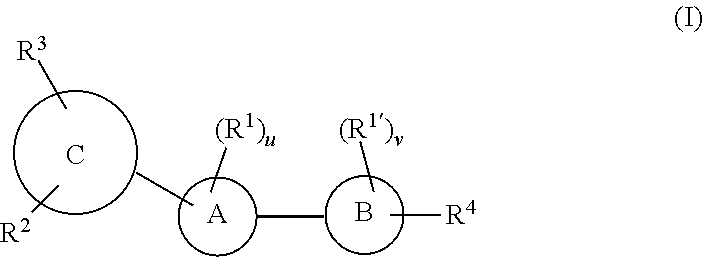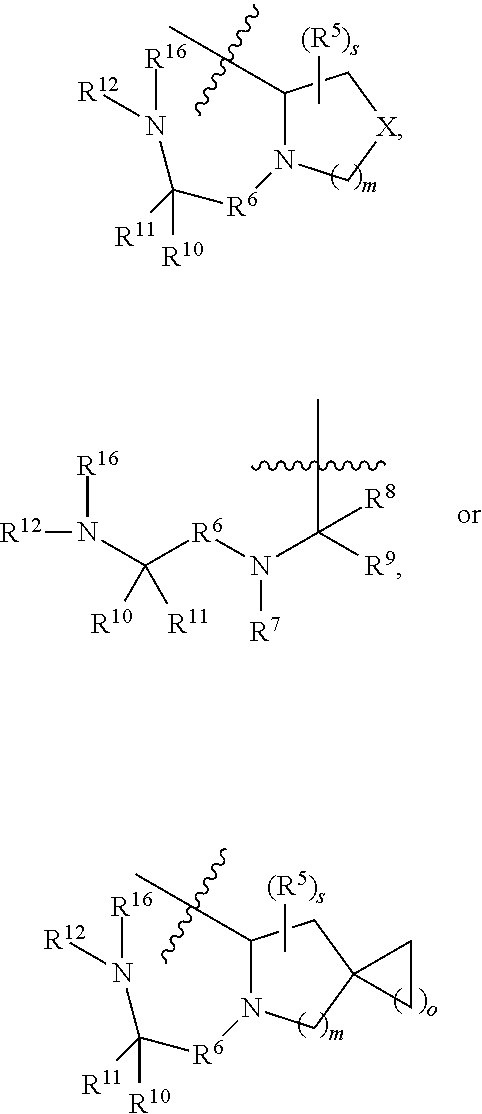Potent and selective inhibitors of hepatitis c virus
- Summary
- Abstract
- Description
- Claims
- Application Information
AI Technical Summary
Benefits of technology
Problems solved by technology
Method used
Image
Examples
specific examples
[0326]Specific compounds which are representative of this invention were prepared as per the following examples and reaction sequences; the examples and the diagrams depicting the reaction sequences are offered by way of illustration, to aid in the understanding of the invention and should not be construed to limit in any way the invention set forth in the claims which follow thereafter. The present compounds can also be used as intermediates in subsequent examples to produce additional compounds of the present invention. No attempt has necessarily been made to optimize the yields obtained in any of the reactions. One skilled in the art would know how to increase such yields through routine variations in reaction times, temperatures, solvents and / or reagents.
[0327]Anhydrous solvents were purchased from Aldrich Chemical Company, Inc. (Milwaukee, Wis.) and EMD Chemicals Inc. (Gibbstown, N.J.). Reagents were purchased from commercial sources. Unless noted otherwise, the materials used ...
example 1
[0328]
(S)-2-(2-([1,1′-biphenyl]-4-yl)-2-oxoethyl) 1-tert-butyl pyrrolidine-1,2-dicarboxylate
[0329]To a stirred suspension of 2-Bromo-4′-phenylacetophenone (3 g, 10.9 mmol, 1 eq) and (tBOc)-L-Proline (2.58 g, 12 mmol, 1.1 eq) in acetonitrile (40 mL) was added DIPEA (2.08 mL, 12 mmol, 1.1 eq) under an argon atmosphere. The reaction was stirred at room temperature approximately 2 h until LC / MS suggested that all the starting material was consumed. The reaction solution was then diluted with AcOEt (250 mL) and washed with H2O (2×100 mL). The organic layer was dried over MgSO4, filtered and evaporated under reduced pressure. The crude compound 1 was then directly engaged into the next step.
[0330]LCMS Calcd for C24H27NO5 409.2, Observed (M-Boc) 310.1
(S)-tert-butyl 2-(5-([1,1′-biphenyl]-4-yl)-1H-imidazol-2-yl)pyrrolidine-1-carboxylate
[0331]A solution of 1 (4.46 g, 10.9 mmol, 1 eq) in toluene (40 mL) was charged with ammonium acetate (16.78 g, 218 mmol, 20 eq) and heated to 95° C. for 16 h ...
example 2
[0337]
Methyl ((S)-3-methyl-1-oxo-1-((S)-2-(5-(4-(4-phenyl-1H-1,2,3-triazol-1-yl)phenyl)-1H-imidazol-2-yl)pyrrolidin-1-yl)butan-2-yl)carbamate
[0338]To a solution of 6 (30 mg, 0.073 mmol, 1 eq) in CHCl3 (0.5 mL) and H2O (0.25 mL) is added successively phenylacetylene (8 μL, 0.073 mmol, 1 eq), CuSO4.5H2O (18 mg, 0.073 mmol, 1 eq), Sodium acetate (14.5 mg, 0.073 mmol, 1 eq) and EtOH (0.5 mL). The resulting mixture was then stirred for approximately 2 h at room temperature until LC / MS suggested that all the starting material was consumed. After evaporation of the volatiles under reduced pressure the crude product was finally purified by column chromatography (DCM / MeOH:95 / 5) to afford compound 7 (20 mg, 55%) as an amorphous solid.
[0339]1H NMR (MeOD) δ 0.87-0.95 (m, 6H), 1.98-2.33 (m, 3H), 3.68 (s, 3H), 3.85-3.90 (m, 1H), 3.95-4.00 (m, 1H), 4.19-4.25 (m, 1H), 5.12-5.17 (m, 1H), 7.33-7.46 (m, 4H), 7.86-7.92 (m, 6H), 8.88-8.92 (m, 1H). LCMS Calcd for C28H31N7O3 513.2, Observed (M+1) 514.1
PUM
| Property | Measurement | Unit |
|---|---|---|
| Molar density | aaaaa | aaaaa |
| Molar density | aaaaa | aaaaa |
| Molar density | aaaaa | aaaaa |
Abstract
Description
Claims
Application Information
 Login to View More
Login to View More - R&D
- Intellectual Property
- Life Sciences
- Materials
- Tech Scout
- Unparalleled Data Quality
- Higher Quality Content
- 60% Fewer Hallucinations
Browse by: Latest US Patents, China's latest patents, Technical Efficacy Thesaurus, Application Domain, Technology Topic, Popular Technical Reports.
© 2025 PatSnap. All rights reserved.Legal|Privacy policy|Modern Slavery Act Transparency Statement|Sitemap|About US| Contact US: help@patsnap.com



